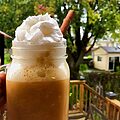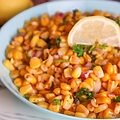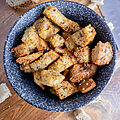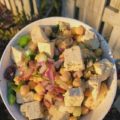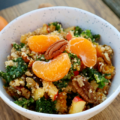
Vegan Gluten Free Pizza Crust
Today we are making a Vegan Gluten Free Pizza Crust! Pizza is undoubtedly one of the most popular foods around the world, and it’s not hard to see why. Whether you’re a fan of classic Margherita, spicy pepperoni, or veggie-loaded toppings, there’s something for everyone. But for those with dietary restrictions, finding a good pizza crust can be a challenge. Gluten-free and vegan pizza crust, in particular, can be hard to come by. Fortunately, with the right ingredients and technique, you can make a delicious and healthy pizza crust right in your own kitchen.
As the demand for gluten-free and plant-based options grows, more and more people are turning to alternative flours to create their favorite dishes. One such flour is brown rice flour, which is made by grinding brown rice grains into a fine powder. Brown rice flour is a great choice for gluten-free baking. It has a mild flavor that won’t overpower the other ingredients. It also has a slightly grainy texture that makes it perfect for pizza crusts, giving this crispy crust a satisfying bite.
Why Brown Rice Flour?
So a little backstory as to how brown rice flour ended up in this specific recipe. Last year, I made a lentil pizza crust which was basically just lentils with spices, and it turned out so scrumptious and fluffy (that recipe isn’t up yet)! Ever since then, the idea of making pizza crusts out of something other than all purpose flour or whole wheat flour is always somewhere in my mind.
The reason I used brown rice flour for this was because when my brother was younger, he had a gluten allergy which ended with our household having bags of various gluten free flours around the house – brown rice flour, coconut flour, almond flour, and more.
Before we get into the recipe, let’s talk about some of the benefits of using brown rice flour. Brown rice flour is rich in nutrients, including fiber, protein, and essential vitamins and minerals like iron and magnesium. It’s also low in fat and easy to digest, making it a great choice for those with digestive issues.
No Rise Pizza
Making a homemade pizza crust recipe may seem daunting, but it’s actually quite simple. With just a few main ingredients, you can create a healthy pizza crust (thin crust!) that’s perfect for topping with your favorite sauce and toppings. You don’t even need to spend hours waiting for the dough to rise! This easy recipe also includes a homemade vegan cheese made from cashews, which is an added nutritional benefit.
This cheese and pizza base recipe is a great option for anyone looking for a healthier and more inclusive pizza option. With its crispy texture and scrumptious flavor, you won’t even miss the traditional wheat flour crust. Give it a try and see for yourself how easy and delicious gluten-free pizza can be!
Why You’ll Love This Vegan Gluten Free Pizza Crust
Adaptable to Different Diets: This pizza is gluten-free, vegan (dairy-free and meat-free) and soy-free! Although it isn’t nut-free, you can opt to just make the crust and forego the cheese to keep it all nut-free. Perfect for all types of dietary preferences!
Unique and Flavorful: The use of brown rice flour in the crust gives it a distinctive flavor and texture, which can be a nice change of pace from more traditional thin crust pizza made from all-purpose or whole wheat flour. Additionally, the homemade cashew cheese is likely to add a delicious and unique flavor to the pizza.
Healthier Option: By using brown rice flour in the crust and cashews in the cheese, this recipe offers a healthier alternative to traditional pizza crusts and cheese, which often contain refined flours, processed cheeses, and animal products. This means that you can enjoy a delicious pizza that’s also good for you!
No Rise: The best part about this quick gluten free pizza dough recipe takes a lot less time than traditional pizza dough does. This is due to the lack of gluten, so the crust does not require that the dough rise for a few hours before using. Get all your favorite pizza toppings out, this pizza will be ready for pizza night in just under two hours from start to finish!
Substitutions
Cashews: I do not recommend to substitute anything for the cashews.
Coconut Sugar: I recommend xylitol as the best option. Other granulated sweeteners may work.
Yeast: Instant yeast and active yeast can be interchanged with one another.
Brown Rice Flour: I do not recommend to try white rice flour, cassava flour or any other gluten-free flour blend. Bob’s Red Mill makes a good brand of brown rice flour to use in this recipe. Other flours absorb moisture differently, and consequently, further ingredients would need to be adjusted if the flour was changed.
Potato Starch: You can substitute arrowroot starch, tapioca starch, cornstarch, or even cornflour for potato starch in a gluten-free pizza crust. Keep in mind that the substitution may affect the texture and flavor of the crust. It’s best to experiment with small amounts and adjust as needed.
Tapioca Starch: Tapioca starch can be substituted with arrowroot starch or cornstarch. Both of these substitutes are also starchy and can help bind the crust together similarly to tapioca starch. However, the texture and taste of the crust may be slightly different depending on the substitute used.
Mixed Herbs: I used a dried Italian seasonings mix that included oregano, parsley and basil.
Nutritional Yeast: If you don’t have nutritional yeast, you can use vegan parmesan cheese.
Apple Cider Vinegar: Lemon juice can be used as a substitute for apple cider vinegar.
Vegan Gluten Free Pizza Crust Notes
- I didn’t refrigerate my dough in advance before using. If doing so, make sure you allow the dough to come to room temperature before rolling it out.
More Gluten Free Recipes You’ll Love
Summer Potato Salad: This summer salad is great to bring along to picnics or a summer BBQ. There’s no mayonnaise in it though – it uses a cashew base for the mayo!
One Pot Vegan Mac N’ Cheese: This recipe uses nutritional yeast for a cheesy flavor blended with sweet potatoes for a creamy sauce over gluten-free macaroni.
Oats & Black Bean Burgers: Black beans and oats form the base of these pan-fried burgers. Slide these into a burger and make a protein-filled meal!
Avocado Macaroni Salad: Creamy avocado sauce coats gluten-free macaroni in a corn and tomatoes green summer salad!
Coconut Milk Sweet Potatoes: These sweet potatoes are soft and full of flavor after cooking in coconut milk!
Thai Salad Recipe: This Thai Salad recipe is a crunchy and colorful salad, coated with a peanut sauce and cilantro with crunchy peanuts as add-ins.
Cranberry Parsley Cheese Ball: This is a vegan cheese ball, but without using any real cheese! The coating is parsley and cranberries (which works great for a festive recipe)!
Garlic Hasselback Potatoes: These potatoes are hasselback, which is a type of Swedish potato dish! Coated in garlic butter and baked, this is perfect as a side dish.
If you make this Vegan Gluten Free Pizza Crust, then leave a comment and star rating! Don’t forget to tag your photos @peanut_palate on Instagram. Enjoy!
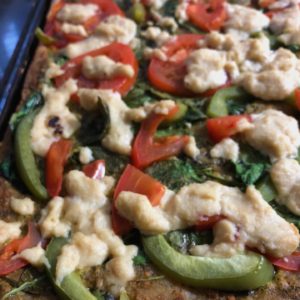
Vegan Gluten Free Pizza Crust
Equipment
- Rectangular Pizza Tray
- High-speed blender or food processor
- Small Saucepan
- Pastry Brush optional, for greasing the pizza tray
Ingredients
For the Crust
- 1½ cup lukewarm water
- 1 tbsp coconut sugar
- 1 tbsp active (regular) yeast
- 1 tbsp instant yeast
- 3 to 3.5 cups brown rice flour
- 1 cup potato starch
- 1 tsp dried Italian herbs mix
- ¼ to ½ tsp pink salt
- vegan butter, avocado oil or olive oil to grease the pizza tray
For the Cheese
- ½ cup raw cashews
- 1 cup water
- 3 tbsp + 2 tsp tapioca starch also known as tapioca flour
- 1 tbsp nutritional yeast
- 1 tsp apple cider vinegar
- ½ tsp pink salt
Instructions
For the Crust
- Mix together the sugar and luke warm water in a large bowl. It needs to be lukewarm in order for the yeast to work properly.
- Sprinkle the yeast on top and cover with a towel for 15 minutes.
- After 15 minutes, add in the rest of the dough ingredients. Start by adding 3 cups of flour, then add extra flour, up to a half cup more as needed for it to become a dough. Mine did not become the type of soft dough you can roll into a ball – it was a *little* more watery than that, but firm enough to pour into a pizza tray.
For the Cheese
- Take the raw cashews and add them to a pot of boiling water on the stovetop for 20 minutes. This will soften them up before using in the recipe.
- After 20 minutes, drain the excess water and add the cashews into a blender or food processor.
- Blend together all ingredients in a blender under smooth.
- Pour the mixture into a saucepan over medium-low heat. Stir for about 6-8 minutes until the cheese is thick.
To Assemble
- Grease a rectangular pizza pan with some vegan butter or oil, then pour the pizza dough on top. Alternatively, line the tray with a baking sheet before adding the dough.
- You don't need a rolling pin to roll out this dough. It should be medium thick, so you might have to use a second tray that you add a bit of the extra dough onto.
- Add pizza sauce and toppings of choice.
- Pour the cheese mixture onto the pizza. The cheese will have to spread in "blobs" as I did in the photo above.
- Bake at 400 F for 20-25 minutes.
- Let the pizza cool before cutting.
Notes
-
Storage
- Store pizza in an airtight container in the refrigerator for up to 3 days. It can be reheated in the oven or microwave.
- Calories have been calculated for each slice (crust + cheese) using a total of 3 cups of brown rice flour and without any sauce or toppings.





